

HuffPost is now a part of Verizon Media. HuffPost is part of Verizon Media.

We and our partners will store and/or access information on your device through the use of cookies and similar technologies, to display personalised ads and content, for ad and content measurement, audience insights and product development. Your personal data that may be used Information about your device and internet connection, including your IP address Browsing and search activity while using Verizon Media websites and apps Precise location Find out more about how we use your information in our Privacy Policy and Cookie Policy.
To enable Verizon Media and our partners to process your personal data select 'I agree', or select 'Manage settings' for more information and to manage your choices. Vampire Ameoba : interestingasfuck. Scientists Have Grown Human Heart Tissue from Skin Cells. Bernhard Jank/Massachusetts General Hospital Medical researchers at the Massachusetts General Hospital (MGH) have successfully used stem cells to grow functioning heart tissue, a major step toward bioengineering organs for people in need of a transplant.
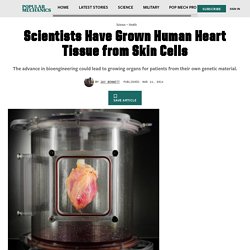
Growing organs from a patient's own genetic material could potentially eliminate the need for a donor and reduce the risk of the patient's immune system rejecting the transplanted organ. A technique using messenger RNA was used to revert skin cells to stem cells. Perineuronal Nets: A Mechanism to Control Brain Plasticity. In 1898, Camillo Golgi, an eminent Italian physician and pathologist, published a landmark paper on the structure of “nervous cells.”
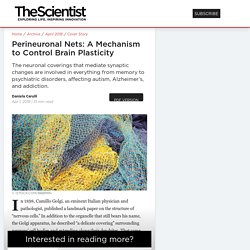
In addition to the organelle that still bears his name, the Golgi apparatus, he described “a delicate covering” surrounding neurons’ cell bodies and extending along their dendrites. That same year, another Italian researcher, Arturo Donaggio, observed that these coverings, now known as perineuronal nets (PNNs), had openings in them, through which, he correctly surmised, axon terminals from neighboring neurons make synapses. Since then, however, PNNs have been largely neglected by the scientific community—especially after Santiago Ramón y Cajal, a fierce rival of Golgi (who would later share the Nobel Prize with him), dismissed them as a histological artifact. Composed of extracellular matrix (ECM) molecules, PNNs form during postnatal development, marking the end of what’s known as the “critical period” of heightened brain plasticity. Learning & the Brain: Neuroscientist Immordino-Yang.
Educators wanting to refine their practice may be thinking they can create an optimal environment for brain based learning.
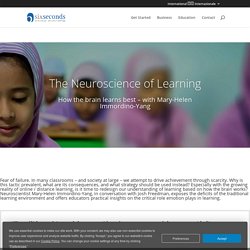
Dr. Immordino-Yang helps us refocus by looking at the goals of learning we are trying to pursue. What kind of learning, skill and practices do we want students to be capable of doing? How Brain Stimulation Can Boost Memory If Paired With Learning. Gain a solid overview of the practical applications of neuroscience in relation to the talent development profession.

Identify how to apply brain-based design and delivery best practices to your learning programs, and receive valuable tools for use on the job. Click image below to learn more. How Brain Stimulation Can Boost Memory If Paired With Learning. How Brainless Slime Molds Redefine Intelligence [Video] Memory: The Remarkable Neuron: Erin Schuman at TEDxCaltech. A paravascular pathway facilitates CSF flow through the brain parenchyma and the clearance of interstitial solutes, including amyloid β. Scientists Discover Previously Unknown Cleansing System in Brain. A previously unrecognized system that drains waste from the brain at a rapid clip has been discovered by neuroscientists at the University of Rochester Medical Center.
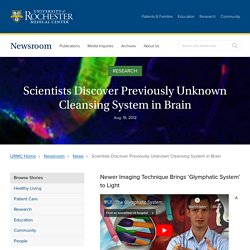
The findings were published online August 15 in Science Translational Medicine. The highly organized system acts like a series of pipes that piggyback on the brain’s blood vessels, sort of a shadow plumbing system that seems to serve much the same function in the brain as the lymph system does in the rest of the body – to drain away waste products. Very long-term memories may be stored in the pattern of holes in the perineuronal net. A hypothesis and the experiments to test it propose that very long-term memories, such as fear conditioning, are stored as the pattern of holes in the perineuronal net (PNN), a specialized ECM that envelops mature neurons and restricts synapse formation.
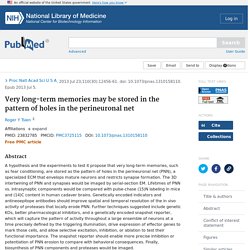
The 3D intertwining of PNN and synapses would be imaged by serial-section EM. Lifetimes of PNN vs. intrasynaptic components would be compared with pulse-chase (15)N labeling in mice and (14)C content in human cadaver brains. Transcranial Direct Current Stimulation Facilitates Associative Learning and Alters Functional Connectivity in the Primate Brain. There has been growing interest in transcranial direct current stimulation (tDCS), a non-invasive technique purported to modulate neural activity via weak, externally applied electric fields.
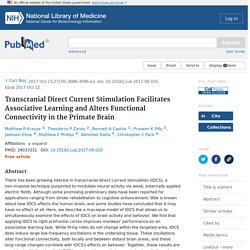
Although some promising preliminary data have been reported for applications ranging from stroke rehabilitation to cognitive enhancement, little is known about how tDCS affects the human brain, and some studies have concluded that it may have no effect at all. Here, we describe a macaque model of tDCS that allows us to simultaneously examine the effects of tDCS on brain activity and behavior. We find that applying tDCS to right prefrontal cortex improves monkeys' performance on an associative learning task.
Lead Exposure In Childhood Linked to Lower IQ, Lower Status. A long-term study of more than 500 children who grew up in the era of leaded gasoline has shown that their exposure to the powerful neurotoxin may have led to a loss of intelligence and occupational standing by the time they reached age 38.

The effects are slight, but significant, showing that the higher the blood lead level in childhood, the greater the loss of IQ points and occupational status in adulthood. The study appears Wednesday in the Journal of the American Medical Association. Study participants are part of a life-long examination of more than 1,000 people born in Dunedin, New Zealand in 1972 and 1973. During their childhood, New Zealand had some of the highest gasoline lead levels in the world. People of Color and the Poor Disproportionately Exposed to Air Pollution, Study Finds – California Health Report. Latinos, African Americans, Asians and low-income people in California are breathing in significantly more tailpipe pollution than other demographic groups in the state, putting them at increased risk for health problems, a new analysis has found.
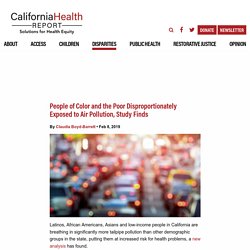
On average, African Americans and Latinos breathe in about 40 percent more particulate matter from cars, trucks and buses than white Californians, according to the study by the Union of Concerned Scientists. Asians are exposed to about 20 percent more pollution. Households earning less than $20,000 a year and people who don’t own cars suffer vehicle pollution levels about 20 percent higher than the state average, the findings show.
Aplidin: Cancer Drug Treats COVID-19 30x Better Than remdesivir. Aplidin comes from a type of sea squirts, marine animals that look like plants. Reinhard Dirscherl/ullstein bild via Getty Images An unexpected COVID-19 drug derived from a rare sea animal and historically used to treat cancer is found to be 27.5 times more effective than the Gilead Sciences’ popular coronavirus drug remdesivir, a study published in the journal Science on Monday revealed. The treatment, known as Aplidin or Plitidepsin, is developed by the Spanish drug company PharmaMar. It has clinical approval in some countries, such as Australia, for treating multiple myeloma, a form of bone marrow cancer. : BrainNet Viewer: Tool/Resource Info.
Google DeepMind. Brain Connection » Powered by Posit Science - Your Brain Health Headquarters. What is the Stress Response. Stress is a biological and psychological response experienced on encountering a threat that we feel we do not have the resources to deal with. A stressor is the stimulus (or threat) that causes stress, e.g. exam, divorce, death of loved one, moving house, loss of job. Sudden and severe stress generally produces: Microsoft PowerPoint - stressphysiology - de_boer_stressphysiology.pdf. Science - Biology - Human - Anatomy - Brain and Nervous System. Treatment-Induced Cortical Reorganization After Stroke in Humans. + Author Affiliations Correspondence to Priv-Doz Dr J. Liepert, Neurologische Klinik der Friedrich Schiller Universität, Philosophenweg 3, D-07743 Jena, Germany. E-mail liepert@neuro.uni-jena.de Abstract Background and Purpose—Injury-induced cortical reorganization is a widely recognized phenomenon.
Conscious and unconscious emotional learning in the human amygdala : Abstract : Nature. Doing the math on Risperdal. Posted by ALT in Mental Health News, Pharmaceuticals. From Risperidone to Ritalin: Lies. Lies. Lies. And Children Are in Danger. Leadership. How Outraged Should We Be By Risperidone (Risperdal)? Formula for Autism Treatment Outrage Video version of this post Click here to watch on YouTube. Risperidone safe, effective, intermediate term treatment for autism. STEPS: Risperidone (Risperdal) for Management of Autistic Disorder. ParkinsonsDBS OnvsOff.
Cortical activities associated with volunt... [Clin Neurophysiol. 2012.
How Running For Our Lives May Have Made Humans Smarter. Mechanisms and Functions of Theta Rhythms - Annu.-Rev.-Neurosci.-2013-Colgin.pdf. 1616.full.pdf. Brain (Hindbrain, Midbrain, Forebrain) How Running For Our Lives May Have Made Humans Smarter. Mike, the Headless Chicken lived for 18 Months - Facts Analysis-HoaxOrFact.com Analysis. V29N06_303.pdf;jsessionid=64C2934528715B81AAA92D1BE7FE5EDF.
Chapter5 Animal Thought. Hypothalamus. Neurologic Effects of Caffeine. Doi:10.1016/j.neuroimage.2004.08.023 - pelchat_johnson_etal_NI2004.pdf. The Kennedy Lab - Gallery - Neurons & Synapses. Neuroplasticity, Psychosocial Genomics, and the Biopsychosocial Paradigm in the 21st Century. Intelligence and physical attractiveness - I2011.pdf. Long Term Memory, Types of Memory and More.
A long-term memory is anything you remember that happened more than a few minutes ago. Novel storage mechanism allows command, control of memory. Long-Term Memory - Types of Memory. Conservation of hypothalamus phylogenetic neuroscience lizard brain. Find in a library : Descartes' error : emotion, reason, and the human brain. Evolution of wakefulness, sleep and hibernation: From reptiles to mammals.
Phylogeny through brain traits: fifteen - PubMed Mobile. Brain Basics: Understanding Sleep. PsycNET - Display Record. MITP Mobile. Rethinking Sleep. Everything you know about drugs is wrong. Types of Memory, Short-Term Memory, Long-Term Memory. Microsoft PowerPoint - Presentation3 - memory.pdf. Learning and Memory (Section 4, Chapter 7) Neuroscience Online. THE BRAIN FROM TOP TO BOTTOM. Declarative Memory (Explicit Memory) and Procedural Memory (Implicit Memory) - Types of Memory.
Unearthing the Phylogenetic Roots of Sleep. Evolution of wakefulness, sleep and hibernation: From reptiles to mammals. The Neurobiology of Sleep: Genetics, cellular physiology and subcortical networks : Abstract : Nature Reviews Neuroscience. ER Visits Related to Brain Stimulants Have Quadrupled - James Hamblin.